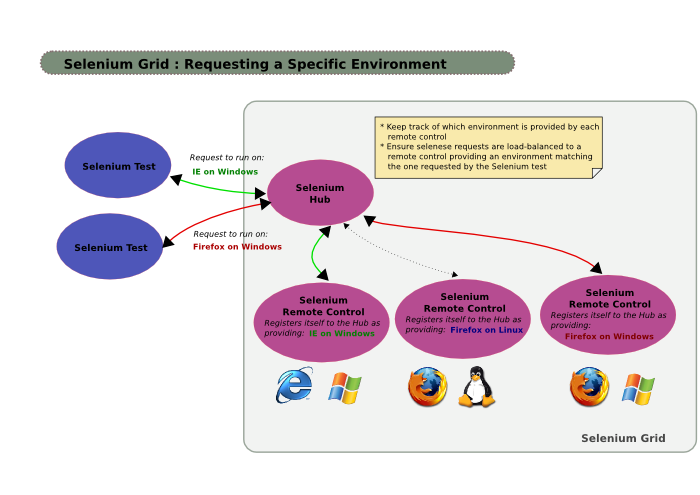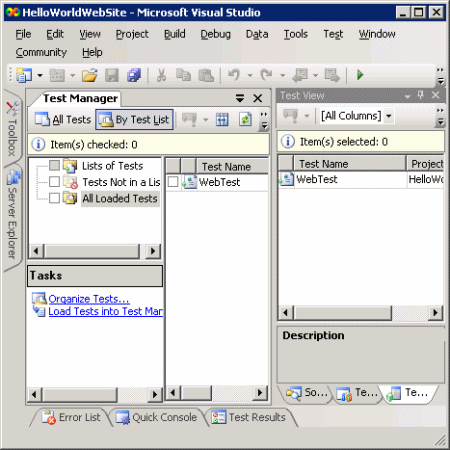-
从小测试员到测试总工程师的英文名称
2008-12-04 08:28:44
-
[转载]比较watir 和 selenium --- Bret Pettichord
2008-12-04 01:15:47
Watir and Selenium
By Bret Pettichord
Two excellent open-source tools for testing web applications are under
development: Watir and Selenium. I?ve been contributing to both. Why?
Wouldn?t it be better to just have one good tool?
Both tools run tests directly in a browser, and both do it in a way
that allows the browser to be minimized while the tests are running,
which means you don?t have to dedicate a machine to running tests. And
both have been used to test significant web applications under
development. But there are also many differences?which ultimately stem
from the different goals they were originally designed to meet.
Watir was developed as a consequence of the scrīpting for Testers
class originally developed by Brian Marick and me. We conceived the
class as a way to help get testers over the programming hurdles to do
automated testing. Ruby?s simple syntax and interactive shell (IRB)
made it a simple language to teach. Of the various automation tasks we
originally presented, we found that the students were most interested
in driving a browser. And the class has come to center on browser-
based testing. Watir is but the latest version of the web-browser
driving library used for that class. Watir was designed both to be
easy to learn, without making any assumptions about the application
being tested. For example, it allows page elements to be identified by
index, name, ID, value or adjacent text. However, the technical
approach we used for the tool restricts it to only working with the IE
browser on Windows. As a tool originally intended for instructional
use, we were willing to live with this limitation. Well, actually, I
was more willing than Brian, who has since become a Mac user.
Jason Huggins, the creator of Selenium had very different objectives.
His foremost goal was to create a tool that would allow him to test
for browser compatibility. He was developing the time tracking system
used inside ThoughtWorks. For in house applications, most IT groups
pick a browser, test the app on it, and then tell their users what to
use. It?s not that easy at ThoughtWorks, however. Our developers are
an ornery bunch and don?t like people to tell them what tools to use.
Although the company provides Windows laptops, many even use Macs or
Linux as their preferred platforms. So it was important to Jason that
he be able to test multiple browsers on multiple platforms. As other
developers at ThoughtWorks have adopted and developed Selenium, they
have also been willing to adapt their web applications to the
requirements of the tool.
In short, Watir was designed for ease of use?but with the expectation
that its users will be programming (rather than recording). Originally
intended as a teaching tool, it was acceptable for the tool to be
limited to IE and Windows. Selenium was designed for breadth of
coverage. It was expected to be used by the same developers who built
the application, so it?s biggest requirement?that it be installed with
the application under test?was acceptable.
Many Watir users report that they are able to quickly get up and
running and productive with Watir even if they don't know Ruby. The
public reception of Selenium is that it's a cool idea that shows
promise.
The biggest complaint with Watir regards it being limited to IE and
Windows. The biggest complaint with Selenium is the requirement for
server-side installation. The other major difference between the tools
is with the novelty of the architecture used. Watir has an
architecture that has often been used before; it benefits from the
experiences of many people who have built similar tools before.
Selenium, on the other hand, represents an original invention. As far
as i know, no one has ever built a tool like Selenium before. This
brings with it some growing pains as people get experience using its
unique approach.
Technically, Watir is a Ruby library that wraps the COM interface to
Internet Explorer. COM is a long-standing Windows-based technology for
making libraries accessible to various languages. (OLE and ActiveX are
other names for approximately the same thing as COM.) Like most
languages, Ruby can access COM interfaces. The COM interface to IE
allows access to the browser?s document object model (DOM). By
directly accessing the DOM, we don?t have to worry about screen
locations or whether the element we wish to access is currently
obscured by another window. Using the DOM allows Watir-based tests to
run in minimized browsers. Many people have built tools to access the
DOM via IE?s COM interface; i call these tools COM/DOM drivers. Samie
and Jiffie are two other open-source COM/DOM drivers, written in Perl
and Java, respectively.
The main thing that distinguishes Watir from other COM/DOM drivers is
the way Paul Rogers and i have designed it to meet the expectations of
non-technical users. Unlike Samie, it automatically anticipates when
it should wait for the next page to load in the browser. It also
provides several commands intended to be used with Ruby?s interactive
shell (called IRB), a language feature found in Ruby?and Python? but
not many of the other popular programming languages. Being able to use
these commands from the interactive shell helps understand the
structure of the web pages they are writing tests for. Watir also has
benefited from a growing community, contributing features and
documentation.
Selenium uses a unique mechanism for driving browsers. Selenium?s
automation engine is written in Javascrīpt and runs inside a browser.
All modern browsers support Javascrīpt, and therefore can be driven by
Selenium. The automation engine, called a browser bot, is embedded in
a page that accessed the application under test in a separate frame.
There?s one snag. Because of something called cross-site scrīpting,
Selenium?s browser bot has to be served from the same site as the
application under test. Thus it has to be installed on the server.
Although Selenium is written in Javascrīpt, Selenium tests are not.
Rather, Selenium supports a command language, called Selenese. Tests
can take one of two forms. They can be embedded in an HTML table,
which will be read in by the browser bot and then executed. These
tests look a lot like Fit-based tests, with the Selenese commands
amounting to a set of action words.
You can also express Selenium tests in a programming language, taking
advantage of language-specific drivers that communicate in Selenese to
the browser bot. Java and Ruby drivers have been released, with dot-
Net and Python drivers under development. These drivers allow you to
write tests in Java, Ruby, Python, C#, or VB.net.
The idea that Selenium has to be installed on the server has turned
off a lot of testers. One called it ?scary.? Developers don?t seem to
mind. One practical concern regards ease of installation. Developers
who are used setting up servers don?t seem to have much trouble
figuring out how install Selenium on their particular server
configuration. With time and experience we?ll see more documentation
on how to install Selenium with typical web application architectures.
And we?ll see Selenium packaged to be easier to install. But the
testers? resistance seems to go beyond the practical concerns with
installability. Some testers are reluctant because they don?t
regularly have direct access to the servers they test. I think others
are scared that it will somehow contaminate the validity of the test
results. I don?t share this concern.
I also won?t be surprised if we eventually see a method for installing
Selenium off the server. Prototypes have been built for mechanisms
that fool the browser into thinking the web app is hosted with the
Selenium server even when it?s really somewhere else, but these
haven't been released yet.
With time, we?ll also see Selenium support more browsers, such as
Safari and Opera. Although the browser bot can run in these browsers,
it needs to be customized for different browsers, because they all
seem to expose their DOM slightly differently. The nice thing about
Selenium is that this customization is all in the browser bot itself;
Selenese commands work with any supported browser.
My plan is to provide multi-browser and platform testing capability to
In the mean time, users must choose between a tester-friendly tool
Watir by allowing it use Selenium?s Ruby driver to drive browsers in
addition to the IE/COM interface that it currently uses. One challenge
will be that IE/COM provides a much more fine-grained interface than
currently provided by Selenium. I anticipate this project will require
new Selenese commands as it progresses. It?ll take a while.
that is limited to IE on Windows and a tool that works with most
browsers but isn?t as easy to use or install. -
自动化测试常用的工具 --- 开源WEB篇
2008-12-03 09:05:16
在世面上的自动化测试工具很多。有开源的,有商业化的,各有各得特色,各有各得优点!下面我就介绍几个我用过的开源自动化测试工具。
1 测试 WEB
SELENIUM 可以说是测试WEB最全面的开源自动化工具, 它可以在WINDOWS, LINUX, MAC 和 SOLARIS 上运行, 而且可以几乎用任何一种编程语言进行构建, 你可以用你熟悉的语言包括 JAVA, C#, PERL, PHP, PYTHON 和 RUBY。 它可以测试的浏览器有IE, FIREFOX, OPERA 和 SAFARI。
SELENIUM 家族成员有:SELENIUM, SELENIUM RC, SELENIUM IDE, SELENIUM CORE, SELENIUM GRID 和 SELENIUM ON RAILS。
GOOGLE 每天都要在他的TESTING FARM上跑几万个SELENIUM测试CASE,现在也些会更多,你如果想学习SELENIUM, 可以从这里开始 http://selenium.seleniumhq.org/

WATIR 是另一个在国外非常流行的自动化测试框架, WATIR 是 WEB AUTOMATION TESTING IN RUBY的缩写, Bret Pettichord 是这个开源项目的主要开发人员, 相信大家读过他的著作《Lessons learned in Software Testing》。 经过一段时间的开源开发, 现在BRET 和他的合伙人PETE开一家公司叫WATIR CRAFT, 提供商业支持, 就像UBUNTU 背后有公司Canonical一样。 WATIR 和 UBUNTU 都是开源的,不过如果你需要特殊的商业支持和功能, WATIR CRAFT 和 CANONICAL 可以为你量身定做。 怎么写着写着,觉得自己在打广告, 呵呵, 不好意思!还是介绍一下WATIR 的功能吧, WATIR 一开始只可以在WINDOWS 上运行,而且之可以测试IE, 不过现在好象是可以测试FIREFOX 和 SAFARI 了。WATIR 只可以用RUBY 来写。
WEBDRIVER 是另一个GOOGLE 正在用的自动化测试软件, 语言是用JAVA, 你可以在这里了解WEBDRIVER,
http://code.google.com/p/webdriver/wiki/GettingStarted
下次我会介绍几个测试WINDOWS APPLICATION 的开源软件, WINDOWS APPLICATION 就是运行在WINDOWS 系统上的程序软件, 举个例子 像 MICROSOFT WORD, SPREADSHEET, NOTEPAD 等等。。。
-
今天开通了 51TESTING 的BLOG
2008-11-26 19:01:03
今天很高兴, 在国内测试门户网站开通了自己的BLOG, 希望和大家多多交流关于测试方面的技术和知识。
WAYNE T.






